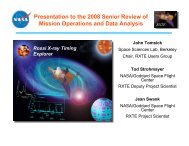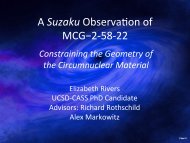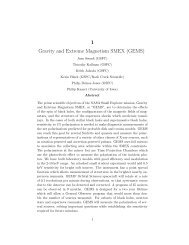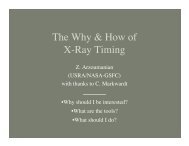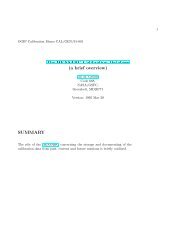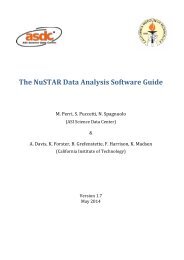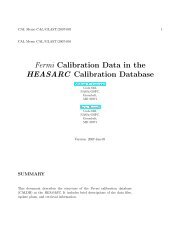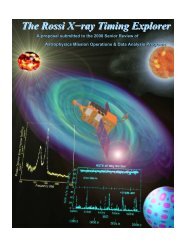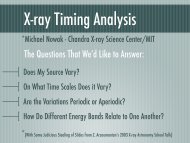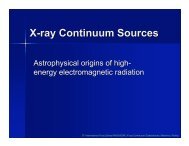SWIFT XRT CALDB RELEASE NOTE SWIFT-XRT ... - HEASARC
SWIFT XRT CALDB RELEASE NOTE SWIFT-XRT ... - HEASARC
SWIFT XRT CALDB RELEASE NOTE SWIFT-XRT ... - HEASARC
Create successful ePaper yourself
Turn your PDF publications into a flip-book with our unique Google optimized e-Paper software.
<strong>SWIFT</strong>-<strong>XRT</strong>-<strong>CALDB</strong>-12Release Date: April 7 th , 2009Prepared by: Olivier Godet 1 , Andrew P. Beardmore 1 , SergioCampana 2 , Giancarlo Cusumano 3Date revised: April 7th, 2009Revision: 1.0Revised by: Olivier Godet1 Leicester, 2 INAF-OAB, 3 INAF-IASF Palermo<strong>SWIFT</strong> <strong>XRT</strong> <strong>CALDB</strong> <strong>RELEASE</strong> <strong>NOTE</strong><strong>SWIFT</strong>-<strong>XRT</strong>-<strong>CALDB</strong>-12: Response matrices andAncillary Response FilesTable 1: Component files being a part of this release. The WT unbroadened kernel RMFsswxwt0s0 − 20010101v011.rmf and swxwt0to2s0 − 20010101v011.rmf should be used for WT data collectedbefore 01-03-2007. The PC RMFs (swxpc0s0 − 20010101v011.rmf and swxpc0to12s0 − 20010101v011.rmf) and(swxpc0s6 − 20010101v011.rmf and swxpc0to12s6 − 20010101v011.rmf) should be used for PC data collected atV ss = 0 & 6 V, respectively. The PC RMFs and the WT unbroadened kernel RMFs (swxwt0s0 − 20010101v011.rmfand swxwt0to2s0 − 20010101v011.rmf) have been described in the previous release note <strong>SWIFT</strong>-<strong>XRT</strong>-<strong>CALDB</strong>-11.Filename Mode Grade Substrate ∗ Start time ◦ End time ◦ Datevoltage (V)swxwt0to2s0 − 20070301v011.rmf WT 0-2 0 01-03-2007 31-08-2007 07-04-2009swxwt0to2s0 − 20070901v011.rmf † 0 01-09-2007swxwt0to2s6 − 20070301v011.rmf ‡ 6 01-03-2001 31-08-2007swxwt0to2s6 − 20070901v011.rmf 6 01-09-2007swxwt0s0 − 20070301v011.rmf WT 0 0 01-03-2007 31-08-2007 07-04-2009swxwt0s0 − 20070901v011.rmf † 0 01-09-2007swxwt0s6 − 20070301v011.rmf ‡ 6 01-03-2001 31-08-2007swxwt0s6 − 20070901v011.rmf 6 01-09-2007∗ The substrate voltage was permanently raised from V ss = 0V to V ss = 6 V on 2007 August 30 (see Section 4).◦ Start and end validity time when the PC and WT RMFs should be used.† The V ss = 0V RMFs swxwt0s0 − 20070901v011.rmf and swxwt0to2s0 − 20070901v011.rmf are a copyof the V ss = 6V RMFs swxwt0s6 − 20070901v011.rmf and swxwt0to2s6 − 20070901v011.rmf.‡ The V ss = 6V RMFs swxwt0s6 − 20070301v011.rmf and swxwt0to2s6 − 20070301v011.rmf are a copyof the V ss = 0V RMFs swxwt0s0 − 20070301v011.rmf and swxwt0to2s0 − 20070301v011.rmf.1
1 Scope of DocumentThis note describes the release of the Swift <strong>XRT</strong> epoch-dependent redistribution matrix (RMF v011) (see Table 1).Files are released only for the Windowed Timing (WT) mode and two different grade selections (grade 0 and grades0-2).The <strong>XRT</strong> effective area is made by three main components: the mirror effective area, the CCD quantum efficiency(QE) and the filter transmission. The QE is included directly in the redistribution matrix files (RMFs). The auxillaryresponse files (ARFs) contain the mirror effective area, the filter transmission, as well as the vignetting correction andthe Point Spread Function (PSF) correction (which depends on the source location and of the size of the extractionregion, as well as on defects on the CCD). Here we report on the <strong>CALDB</strong> RMF and ARF files which represent theeffective area of the telescope for a nominal on-axis observation (no vignetting correction) and for an infinite regionof interest (no correction for PSF losses). RMF files do not include the PSF correction and do not depend on thesource position on the detector. The CCD soft energy response is sufficiently uniform within the central 200x200pixels (see e.g. previous RMF release notes), therefore there is just one RMF file per mode and grade selection andper epoch. The ARF files, instead, need vignetting and PSF corrections and, therefore, need to be built for eachobservation. To produce the observation-specific ARF files, the <strong>XRT</strong>MKARF task (<strong>XRT</strong>DAS-HEADAS software) hasbeen developed. This task corrects the nominal ARF file for the vignetting and, optionally (psfflag=yes), for PSFlosses. This task includes corrections for CCD defects with the inclusion of an exposure map automatically generatedby the data analysis pipeline (expofile=filename.img). The adopted calibration method implies that we include theresidual correction of the CCD quantum efficiency in the <strong>CALDB</strong> ARF files, accounting for why the nominal ARFfiles are different for different grade selection.Motivations of this release:Radiation and high-energy proton damage on the CCD (the imaging area, the store frame area and the serialregister) over time result in the build-up of charge traps (i.e. faults in the Si crystalline structure of the CCD). Thedeepest faults are responsible for the line FHWM degradation, the line shape then showing a more pronounced lowenergy wing (see Section 2 and Fig. 1(a)). The most serious of these charge traps can cause a loss of up to 350 eVfrom the incident X-ray energy.In this release, the WT RMFs are newly computed files including an epoch-dependent broadened kernel handlingthe evolution of the line broadening over time (see below), while the PC unbroadened kernel RMFs and the WT &PC ARFs are the same as those issued in the previous release <strong>SWIFT</strong>-<strong>XRT</strong>-<strong>CALDB</strong>-11.File naming scheme:On 2007 August 30 (at 14:28UT), the CCD substrate voltage was raised from V ss = 0V to V ss = 6 V. The changewas made in order to reduce the thermally induced dark current in the CCD, which allows the <strong>XRT</strong> to collect usefulscience data at slightly higher temperatures (3 to 4C) than was possible before the change. The change in substratevoltage has made it necessary to release two sets of RMF/ARF files, now distinguished by the characters ’s0’ and’s6’ in their file names. At the moment the V ss = 6V files are placeholders and identical to the 0V files (see theprevious release <strong>SWIFT</strong>-<strong>XRT</strong>-<strong>CALDB</strong>-11 and see Table 1).To model the evolution of the <strong>XRT</strong> spectral response over time, we release three sets of WT RMFs (for both grade 0and grades 0-2). The first set of WT RMFs (being the same as those issued in the previous release <strong>SWIFT</strong>-<strong>XRT</strong>-<strong>CALDB</strong>-11) should be used for data collected from launch to 2007 February 28 (swxwt0to2s0 − 20010101v011.rmf andswxwt0s0 − 20010101v011.rmf). The second and third sets of WT RMFs including an epoch-dependent broadenedkernel should be used for data collected from 2007 March 1 to 2007 August 31 (swxwt0to2s0 − 20070301v011.rmfand swxwt0s0 − 20070301v011.rmf) and from 2007 September 1 onwards (swxwt0to2s6 − 20070901v011.rmfand swxwt0s6 − 20070901v011.rmf), respectively. (see Table 1 and Fig. 2). The PC RMFs are the same as those issuedin the previous release <strong>SWIFT</strong>-<strong>XRT</strong>-<strong>CALDB</strong>-11 (swxpc0s0 − 20010101v011.rmf, swxpc0s6 − 20010101v011.rmfswxpc0to12s0 − 20010101v011.rmf and swxpc0to12s6 − 20010101v011.rmf).2 RMF generationThe Response Matrix Files (RMFs) are created by a Monte-Carlo simulation code (Godet et al. 2009, A&A, 494, 775,Godet et al. 2007, SPIE, 6686, 6686OA1). This code models: transmission of the incident X-rays through the CCDelectrode structure; photo-absorption in the active layers of the device; charge cloud generation, transportation andspreading; silicon fluorescence and its associated escape peak; surface loss effects; mapping of the resultant chargecloudto the detector pixel array; charge transfer efficiency; addition of electronic read-out noise; event thresholdingand classification according to the specific mode of operation.Past improvements: In the release <strong>SWIFT</strong>-<strong>XRT</strong>-<strong>CALDB</strong>-08, in orbit observations of the soft calibration sourceswere used to refine the surface loss function in order to better match the spectral redistribution at low energies.While for heavily absorbed sources, the parameterisation of the redistribution of high energy X-rays down to lowenergies was improved for both PC and WT modes (using SNR G21.5, SGR 1900+14 & NGC 7172 for PC, and2
i) a loss of events at low-energy below the on-board energy threshold (see panel (b) in Fig. 1) implying a decrease ofthe apparent flux level by 15-20% from February 2005 to June 2007 when fitting the spectra of the soft neutron starRXJ1856.4-3754; ii) negative residuals (less than 10%) around the instrumental edges in featureless spectra whichstarted to be clearly observed from March 2007 in high statistical quality PC & WT spectra (see panel (c) in Fig. 1).2normalized counts s −1 keV −110.50.2normalized counts s −1 keV −10.10.01ratio1.41.210.80.5Energy (keV)1ratio32.521.510.50.5Energy (keV)Figure 2: Top panel - SNR E0102-72.3 from June 2007 data (black: the current WT grade0-2 RMF swxwt0to2s0 − 20010101v011.rmf; red: the new broadened WT grade 0-2 RMFswxwt0to2s0 − 20070301v011.rmf). The spectral model is based on an XMM/RGS-PN model (see Plucinskyet al. 2008, Proc. SPIE, arXiv0807:2176). Bottom left panel - SNR E0102-72.3 from August 2008 data fittedusing the new broadened WT grade 0-2 RMF swxwt0to2s6 − 20070901v011.rmf and the XMM/RGS-PN model.The WT grade spectra contain more than 2 × 10 4 counts. In both cases, the spectra were extracted using datawhen the source was not located on the bad columns. Bottom right panel - RXJ 1856.4-3754 from July 2008 g0(red) and g0-2 (black) data using the new broadened WT RMFs (swxwt0s6 − 20070901v011.rmf). The spectrumis fitted using the model described in Beuermann et al. (2006, A&A, 458, 541). The normalisation relative to thatgiven in the Beuermann et al. model is C = 0.92 ± 0.02; which is close to that derived using 2005-2006 data of RXJ1856.4-3754 (C = 0.96 ± 0.03).To produce these new WT RMFs, we convolved each of the 2400 monochromatic line input spectra of the v011WT RMFs (see Godet et al., 2009, A&A, 494, 775) with a function f. The profile of the function f should depend onseveral parameters related to the physical behaviour of charge traps on the CCD such as i) the position of the chargetraps on the CCD; ii) their depth (i.e. their energy shifting effect); iii) the photon energy; iv) the CCD temperaturewhich could affect the time relaxation of the trapped charges; v) the source count rates which, if too high, can fillcompletely the charge traps so that their effects on the spectral response are no longer visible. However, most of thisinformation is unknown, and therefore it is not possible to work out the exact profile of the function f with energy.So, we defined an empirical function f, its energy-dependent width was calibrated using an iterative method basedon fits of several datasets: Mkn421 (from March 2007 to February 2009), the SNR E0102-72.3 (from June 2007 to4
August 2008), RX J1856.4-3754 (from June 2007 to August 2008). Fig. 2 shows a comparison of the performanceof these new WT RMFs when compared with these obtained using the version 11 WT RMFs (designed for datacollected before 2007 February 28). In all cases, the residuals are flattened. These new WT RMFs also enable toretrieve a value of the normalisation relative to that given in the Beuermann et al. (2006, A&A, 458, 541) model(C = 0.92 ± 0.02 from July 2008) close to that derived using 2005-2006 data of RX J1856.4-3754 (C = 0.96 ± 0.03),since the QE profile at low energy takes into account the fraction of events lost below the on-board threshold (seeFig. 3).−− v011 g0−2 RMFQuantum Efficiency0 0.2 0.4 0.6−− v012 g0−2 RMF from 2007 March 1 to 2007 August 31−− v012 g0−2 RMF from 2007 September 1 onwards0.5Energy (keV)1Figure 3: WT grade 0-2 QE curves in the 0.3-1keV energy band: (black) v011 RMF, (red) v011RMF to be used from 2007 March 1 to 2007 August31; (green) v011 RMF from 2007 September 1 andonwards. The loss of QE at low energy in the v011RMFs is due to the loss of events below the onboardcentral event threshold due to the build-upof charge traps.3 Current limitations and future prospectsWe recommend to fit the <strong>XRT</strong> WT spectra in the 0.3-10 keV energy range with these epoch-dependent <strong>XRT</strong> responsefiles (version 11). The following considerations apply to both WT and PC mode observations:• 10-15% spectral fit residuals in the 1.5-2 keV energy band can be visible in high statistical quality spectra(mostly in WT mode, because the sources observed are much brighter) using the v011 response files (alsovisible using previous versions). This is due to an overestimation of the effective area in that region induced bythe change of the substrate voltage from 0 V to 6V, which slightly reduced the depletion depth. The creationof both PC and WT RMFs including the effective area correction is under investigation and will be releasedas soon as possible.• The v011 WT RMFs with a broadened kernel are designed to model the averaged behaviour of the linebroadening in a given time interval. We have investigated the effects of source count rates (below 50 countss −1 ), CCD temperatures (from −70 ◦ C to −50 ◦ C) and location of the sources in the WT window (from column200 to column 400) during the calibration of the v011 WT RMFs. Even if these latter parameters are inthe ranges considered (and on the calibration sources considered they seem to have a second order effect), wecannot garantee that the broadening of the WT RMF kernel will be suitable in every case. In particular, thebroadening scheme adopted in this release treats only the average behaviour of the increasing charge traps.Individual traps may affect specific datasets more strongly.• The creation of PC RMFs with a broadened kernel is under investigation and will be released as soon aspossible.• Prospects to implement a column by column description of the bias correction in the ground software enablingto correct for the effects of traps are under investigation for PC and WT data after June 2007 (see Fig.4 in therelease <strong>SWIFT</strong>-<strong>XRT</strong>-<strong>CALDB</strong>-11 and Godet et al. 2009, A&A, 494, 775).• Even if the new WT broadened RMFs significantly improves the fitting residuals, there is still room for improvement.5



